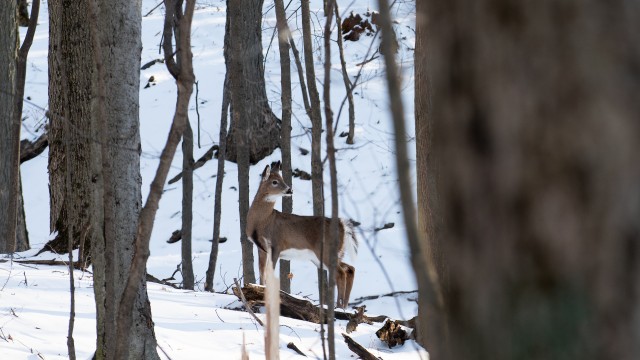The white-tailed deer (Odocoileus virginianus) is well known to Gault Nature Reserve visitors. Deer encounters while hiking or around the mountain are increasingly frequent. Indeed, deer populations across northeastern America have increased drastically in the last few decades. Did you know that the deer population at the Reserve has been at the center of many research projects dating back to 2006? Some of our long-term monitoring projects measure their impacts on the vegetation. Other projects are defining the distribution of individuals on the mountain. These projects usually have one underlying question in common: how many deer are there?
Monitoring deer population sizes is an important conservation issue. Overabundant deer can have profound negative impacts on the health of the forest. Unfortunately, we cannot ask the deer to line up every few years for us to count or to fill out a census. Scientists thus must be creative when coming up with strategies. Most often, they will use winter to their advantage. When the trees have shed their leaves, deer are easier to spot. Scientists can then count them by flying in a helicopter, for example. Dr. Tim Elrick, Director of the Geographic Information Center at McGill University, has also been testing the use of infrared drones. In recent years, graduate students in the lab of Dr. Virginie Millien, Associate Professor and Chief Curator and Curator of Paleontology & Zoology, McGill University’s Redpath Museum, have been using camera traps to study white-tailed deer. This technique has the advantage of working in any season.
Harnessing new technologies
Camera traps are activated by movement. When an animal walks in front of a camera, it will take photographs or videos. This kind of insight into the secret world of animals is hard to get by any other means. The cameras allow biologists to step away from the field. They can thus observe animals without disturbing them. In this way, biologists can learn more about the behaviour of animals when humans are not around. Camera traps also have the advantage of not needing to sleep, eat, or take a break. They can do the scientists' work while they focus on something else!

A doe crosses one of the Reserve's hiking trail (photo: Alex Tran)
More and more studies now use camera traps to estimate population sizes or find rare or shy species. Recent technological advances allow scientists to do their jobs more efficiently. Over the years, camera trap prices have gone down, and image quality has increased. Scientists are now recruiting the help of artificial intelligence to analyze the data from camera traps faster. With creativity, new tools like camera traps, drones, and machine learning can help us better understand - and ultimately protect - our ecosystems.
Frédérique Truchon
Communications associate
Gault Nature Reserve of McGill University
Header : The fur of white-tailed deer (Odocoileus virginianus) becomes greyer in the winter for better camouflage (photo: Alex Tran)





